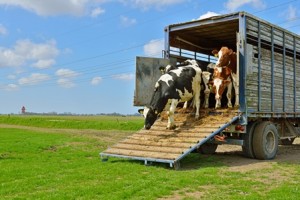Cattle Diseases
Pasteurellosis in Cattle
Also known as: Transit Fever, Shipping Fever
Pneumonic pasteurellosis is most commonly seen in recently weaned, single-suckled beef calves after housing or transport to a new herd/premises. The disease is commonly associated with mixing and confining calves of multiple origin at cattle markets or new destinations and is often seen within a couple of weeks after arrival at a fattening unit (Dalgleish, 1990). The primary causative agents of pneumonic pasteurellosis are two bacteria: Mannheimia (Pasteurella) haemolytica (most important) and Pasteurella multocida (not per definition pasteurellosis)
Mannheimia haemolytica is usually the primary pathogen causing transit fever. There are two recognised serotypes causing disease types A1 and A6. It is found in the nasal passages of a number of healthy carrier animals, with outbreaks of disease precipitated by stress and mixing of animals (Confer et al. 1993). Pasteurella multocida is also carried by healthy animals and is usually a secondary pathogen, invading pre-existing damaged airways. The acute disease manifests itself with fever, rapid breathing and nasal discharge. Some deaths may occur and many animals remain dull and anorexic for a period after recovery, causing significant economic losses in retarded growth rates. Calves may also progress to cases of chronic pneumonia which often fail to finish.
Data on the prevalence/incidence collated from published and unpublished sources summarised by Bennett et al., 1999 suggest that 10-15% of all finishing beef cattle are at risk at any given time in the UK. The same source also quotes unpublished data of a farmer survey, where 46% of beef finishing herds reported pneumonia outbreaks or individual cases within the past year (including all types of pneumonia). It is estimated that about 10% of the animals within the herd suffer from pneumonic pasteurellosis in an outbreak, even though higher morbidity rates have been recorded (Dalgleish, 1990; Otter and Farrer, 1997).
Controlling and Preventing Pasteurellosis
Whilst it has now been accepted that Pasteurella spp. and Mannheimia spp. are the primary cause of pneumonic pasteurellosis, nevertheless, viral infections and stress (travel, transport, new environment, mixing with new animals etc.) are important factors that predispose calves to the disease. Consequently, the disease is primarily a problem in beef fattening units, particularly in those where weaned calves are bought in from other farms via a cattle market.
Prevention and control of pneumonic pasteurellosis has centred on the predisposing factors in combination with vaccination where herds are at high risk.
The following steps can be taken to reduce the likelihood of infection:
- Calves should be weaned and introduced to fattening diet at least two weeks before leaving the farm.
- Calves should be sold in groups that could stay together at the receiving farm.
- Calves should also be transported from the farm of origin directly to the fattening unit.
- The transport distances should be as short as possible
- The animals should be handled in a calm and considerate manner at all stages of the transport (Andrews et al., 1981; Dalgleish, 1990; Andrews, 1992).
Treating Pasteurellosis
Early treatment with antibiotics, at the first sign of symptoms, is effective in reducing mortality and ensuring full recovery. The recovery, however, tends to take up to seven days, even when antibiotics are used. A number of antimicrobials are available which should be effective, with the decision on which one to use based on method and frequency of dosing and cost. The use of non-steroidal anti-inflammatory agents has been shown to be beneficial in speeding recovery and reducing residual lung damage.
Metaphylactic treatment of in-contact animals, particularly animals that arrived in the same batch as the affected ones, is carried out by many practitioners (Dalgleish, 1990), but should be minimized to limit the spread of antimicrobial resistance. Isolation of the affected animal(s) may help if done early in the course although many in-contact animals will already have contracted the infection during transport or in the market.
Pasteurellosis and Welfare
Transport of young animals from one farm to another and mixing of animals of different origin expose the animals to various diseases and stress. Pneumonic pasteurellosis is just one of many such diseases. In pasture based systems, calves should ideally be reared to fattening on the farm of origin. If calves need to be transported, however, precautions should be taken to ensure high welfare standards.
In the face of an outbreak of pneumonic pasteurellosis, it is important to treat the affected and in-contact animals with antibiotics and anti-inflammatory drugs as early as possible. A vet should be called in to assess the situation.
Good Practice Based on Current Knowledge
- Animals should be reared on the farm of origin
- Maintain a closed herd
- At-risk animals with signs of respiratory disease and in-contacts should be treated with antibiotics and anti-inflammatory agents at the first sign of disease
If weaned calves need to be transported from one farm to another, they should be:
- Weaned and introduced to fattening diet at least two weeks before transport
- Sold directly to the buyer (no cattle markets)
- Preferably, sold to farms that accept batches of calves
- Sold only to farms within a short transport distance
- Transported by reliable and experienced transporters
- Not transported if they are weak or sick/injured


 American English
American English


Comments are closed.